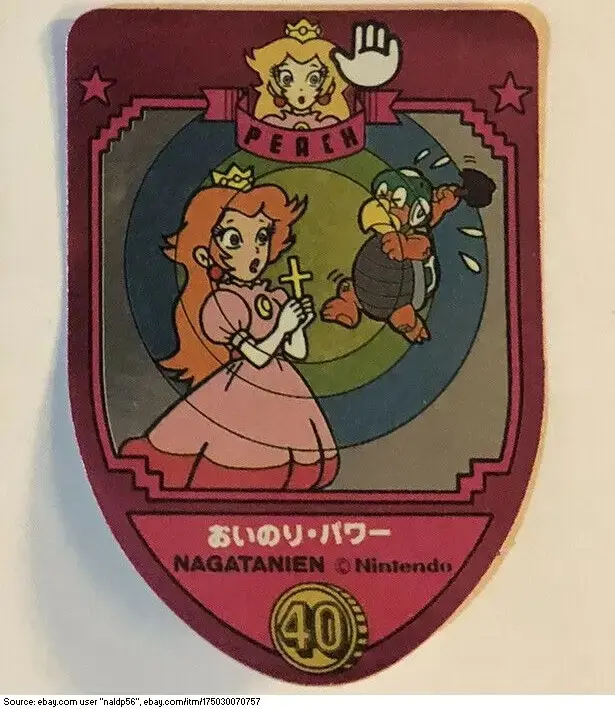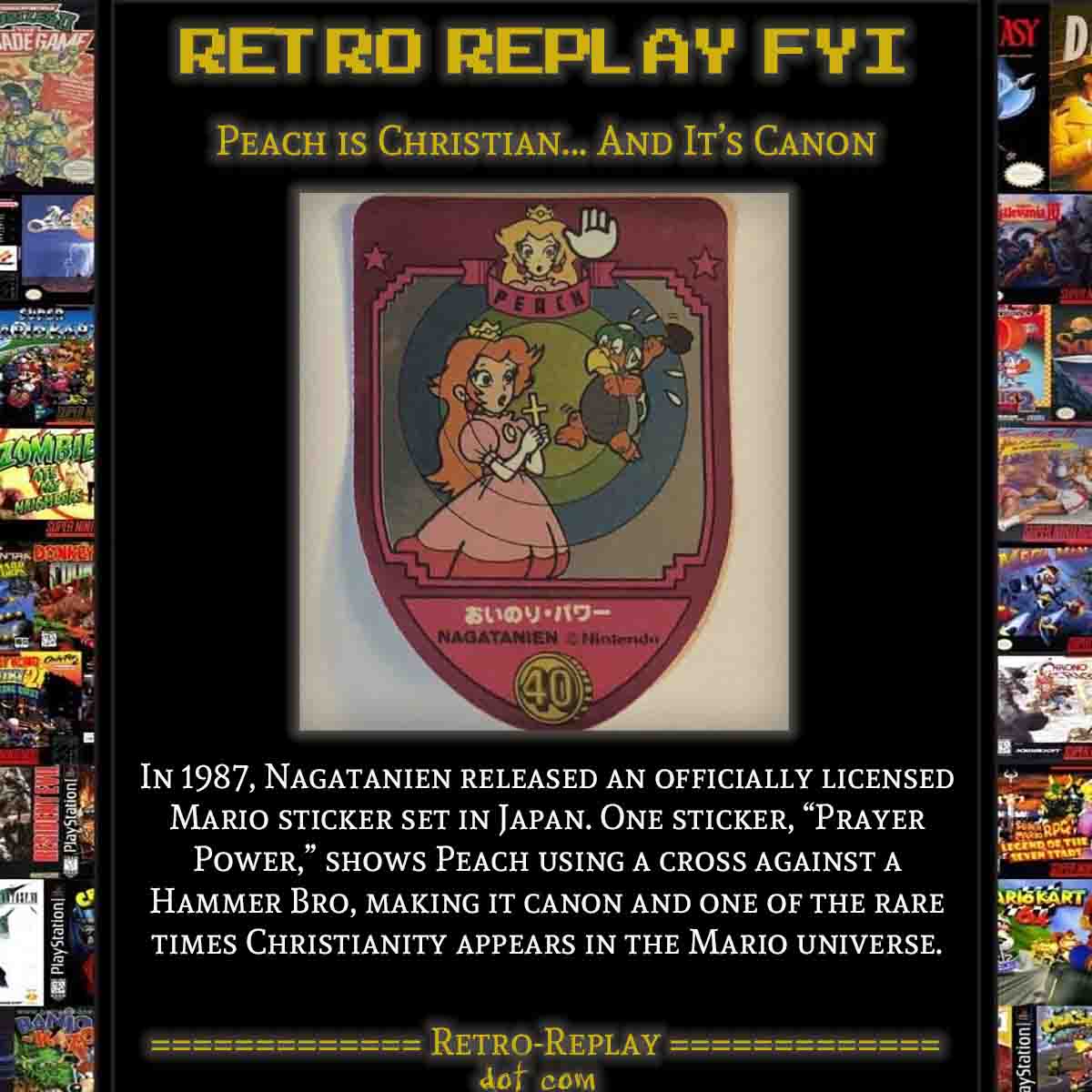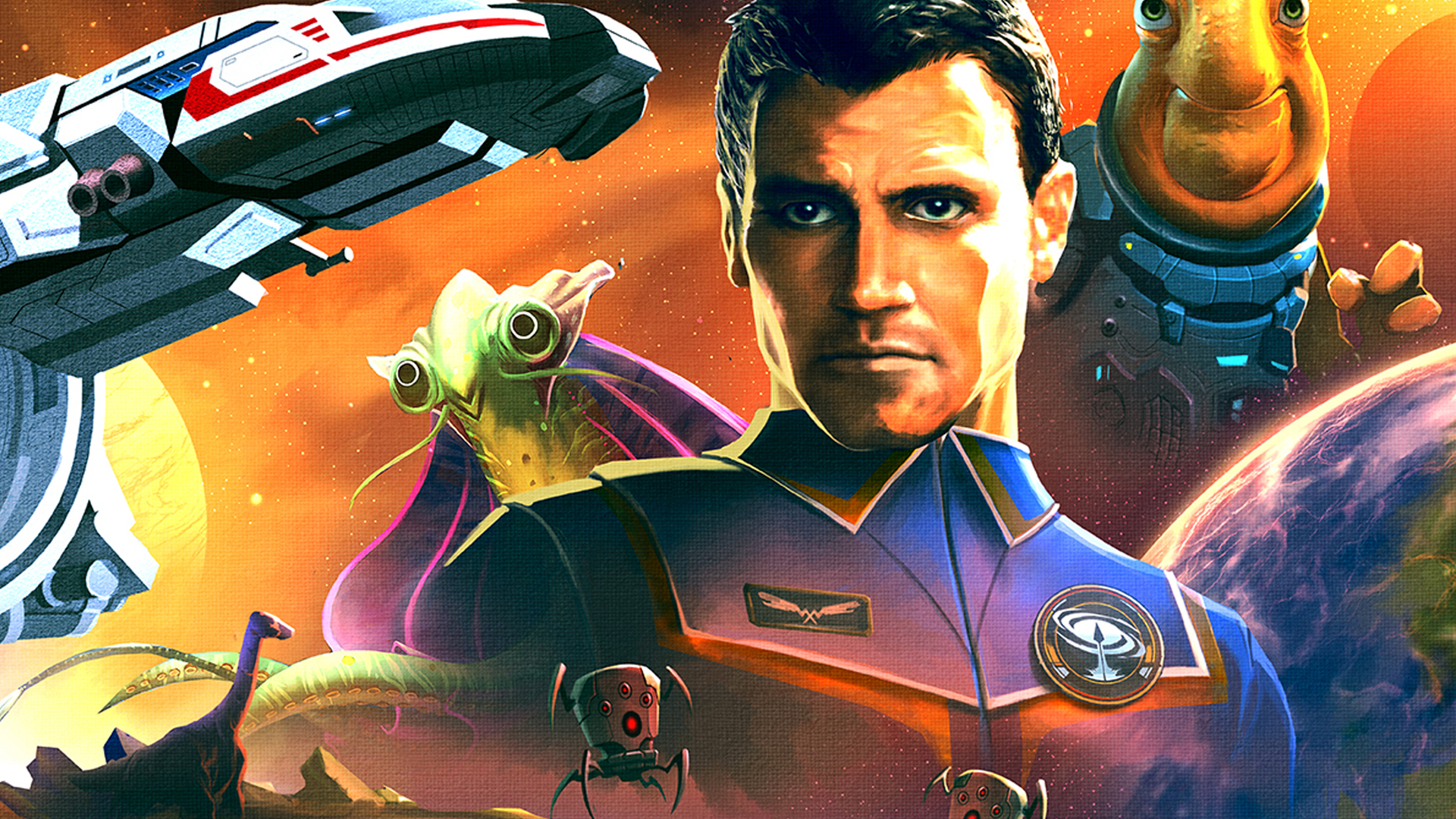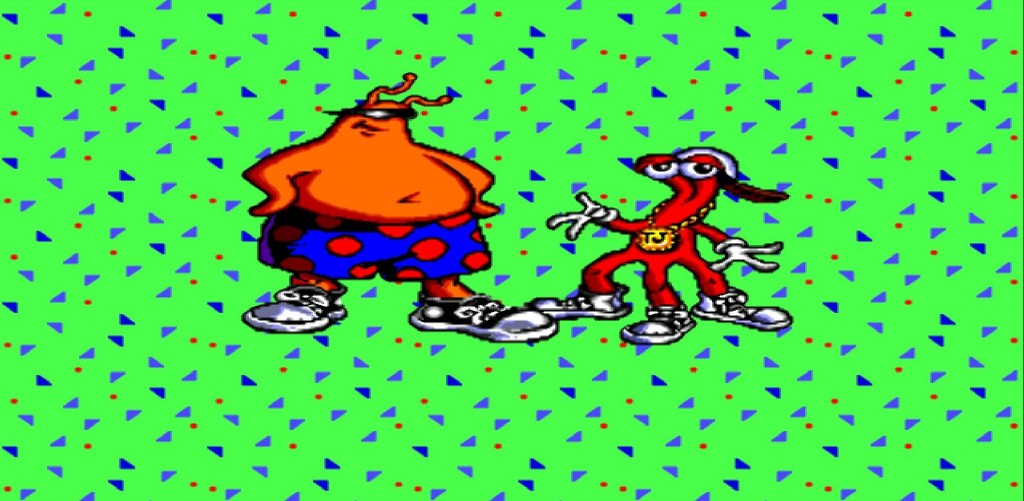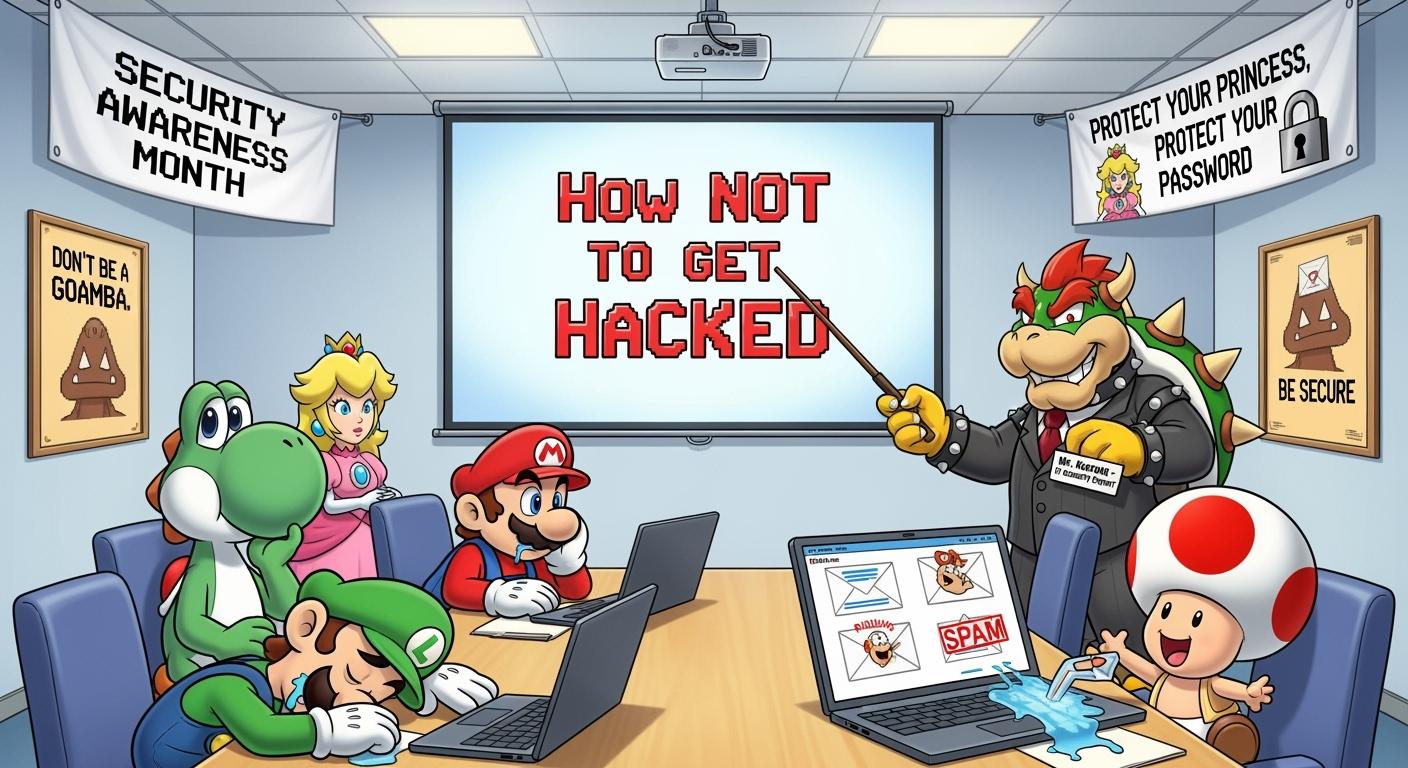Peach is Christian too?
The Mario franchise has always been a cultural touchstone, carefully managed by Nintendo to avoid controversy. For decades, the Mushroom Kingdom has relied on fantasy imagery like mushrooms, stars, and fire flowers rather than religious symbols. Yet in 1987, one of the strangest and rarest pieces of Mario merchandise slipped through: a sticker called Prayer Power, showing Princess Peach clutching a Christian cross to repel a Hammer Bro.
(HEY YOU!! We hope you enjoy! We try not to run ads. So basically, this is a very expensive hobby running this site. Please consider joining us for updates, forums, and more. Network w/ us to make some cash or friends while retro gaming, and you can win some free retro games for posting. Okay, carry on 👍)
This was no bootleg. The sticker was produced by Japanese food company Nagatanien as part of an officially licensed Super Mario Bros. promotion. That makes it canon, at least in the sense that Nintendo approved the art. For fans of both retro gaming and faith in media, the Prayer Power sticker is one of the more fun and shocking discoveries of Mario history, and it echoes what we have explored previously about how Link was Christian.
But where did this sticker come from, why was it made, and what does it tell us about Nintendo in the late 1980s?
Nagatanien and the Mario Sticker Campaign
Nagatanien is a well-known Japanese food manufacturer that has produced instant soups, seasonings, and packaged meals for decades. In the 1980s, the company partnered with Nintendo to release Mario-themed promotions tied to grocery items. These included not just food packaging with Mario characters but also prizes and collectible stickers.
The sticker promotion in question launched in Showa 62 (1987) and ran for six months, from January to June. Customers could cut out special entry tickets from Nagatanien products, mail them in, and hope to win one of several official Mario-themed prizes.
The back of one surviving card confirms the details of the giveaway. Each week, 2,000 winners were selected, for a total of 52,000 prizes distributed over the life of the campaign. Prizes included Mario wristwatches, Mario cameras, and, most importantly, the Super Mario Orion Cards. These Orion Cards were the collectible stickers, two per set, with a case included… given to 700 winners weekly. That means only 18,200 sticker sets were ever distributed, which explains why so few have survived.
This promotional structure makes the stickers incredibly rare and highly sought after among collectors today.
The “Prayer Power” Sticker
Among the various Nagatanien stickers lies the most striking piece of all: the Prayer Power card. The design shows Princess Peach, her hands clasped around a golden cross, standing firm against a Hammer Bro who recoils in fear. The Japanese text at the bottom reads おいのり・パワー (Oinori Pawā), literally translated as Prayer Power.
The card also bears the Nagatanien name and the official © Nintendo copyright, confirming it was licensed. This is no rumor, no fan-made creation — it is authentic. While many Mario oddities have emerged from the unregulated days of cereal box toys and third-party licensing, this one is particularly unusual because it openly uses Christian symbolism.
The message is unmistakable: Peach’s faith is a weapon strong enough to drive away evil. In a universe where magic mushrooms and stars dominate the iconography, this sticker stands apart as a cultural anomaly, and as canon.
The Back of the Card Explained
One point of confusion has been the numbers printed on the back of these cards. Some collectors wondered if the “30” referred to the total number of cards in the set. However, translation shows that it actually refers to the campaign’s end date: June 30, 1987.
The full text explains the giveaway rules. Every week, 2,000 winners were chosen, and the prizes were divided into categories:
700 winners received a set of two Mario Orion cards plus a case.
700 winners received a Mario wristwatch.
600 winners received a Mario camera.
The deadline was June 30, 1987, and winners were notified by mail. There is no evidence of a published checklist, which means we still do not know the exact number of unique sticker designs in the set.

This makes building a full record of the Nagatanien Mario stickers difficult. Based on what has surfaced, collectors believe there may have been around 30 designs, but without documentation, this remains speculation.
Collectibility and Surviving Examples
The Prayer Power sticker first caught wide attention through online collectors and a now-inactive eBay listing. Unfortunately, the listing was not preserved by the Wayback Machine, leaving us with screenshots and secondhand documentation.
Other Nagatanien stickers from the same series can still be found, however. For example, you can see a verified card from the set on this current eBay listing. These surviving examples help establish that the Prayer Power card fits within a legitimate series, even if the exact number of designs remains unknown.
Because the cards were distributed as limited prizes and not mass-sold, their rarity is extreme. Very few have surfaced, and those that do tend to sell quickly. It is likely that most of the 18,200 card sets given away in 1987 have been lost to time.
Fan and Collector Reactions
The Prayer Power sticker came to broader public attention thanks to Mario Broth Blog on Twitter, which shared the image and context. Reactions ranged from disbelief to amusement. Some fans likened Peach’s pose to an exorcism scene, while others joked about the strangeness of seeing Christianity depicted in Mushroom Kingdom canon.
For many, the shock was less about the sticker itself and more about what it represents: a time when Nintendo was less rigid in its control of the Mario brand. Today, such imagery would be unthinkable in official merchandise. But in 1987, when Mario was spreading across the globe and licensing deals were plentiful, these oddities could slip through.
Why do I care?
The Prayer Power sticker is more than a curiosity. It is a window into the cultural and commercial landscape of the late 1980s. It shows how Nintendo, through licensed partners like Nagatanien, allowed its characters to be used in ways that might feel off-brand today. It also demonstrates that Christianity has touched Mario canon, however briefly, in a way that is undeniable.
For gaming historians, this sticker is evidence of how promotional merchandise can carry significant meaning. It reminds us that not all of Mario’s history is written in game cartridges, some of it lives in the ephemera of grocery store giveaways and mail-in prizes.
And for collectors, the sticker is a holy grail, one of the rarest examples of Nintendo memorabilia to feature explicit religious imagery.
The 1987 Nagatanien Prayer Power sticker remains one of the strangest and most important artifacts of Mario history. Peach, holding a cross to repel a Hammer Bro, is more than an odd image, it is an officially licensed moment of Christianity in Mario canon.
Because these stickers were distributed only as contest prizes, their numbers are limited and their survival rate is low. No checklist has surfaced, and we do not know how many unique designs exist. We are still learning, and the hunt continues.
If you own more of these stickers, or if you know details of the original Nagatanien campaign, please reach out. Every piece of information helps us reconstruct this lost chapter of Nintendo history.
 Retro Replay Retro Replay gaming reviews, news, emulation, geek stuff and more!
Retro Replay Retro Replay gaming reviews, news, emulation, geek stuff and more!

